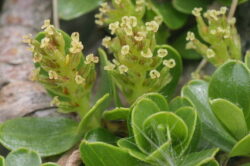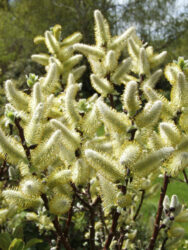In this article, we will discover how to grow the shrubby Salix in containers. We are not talking about the trees, so often seen in gardens but the smaller, minute species that can be grown in containers. These smaller, shrubby willows have an interesting and impressive display of catkins. The beauty of the plants is that they are small and not imposing like the trees you often find.
Salix is a relatively large genus of 400 species of mostly deciduous trees and shrubs belonging to the Salicaceae (the Salix or Willow) family. They have the common name of Sallows, Osters or Willow. They tend to find growing in cold and temperate regions of the world.

Several shrubby species can be possibly grown in a container garden and these will be discussed later.
Willows tend to have sap, which is high in salicylic acid and have large fibrous stoloniferous roots, with tough wood and slender branches. The leaves are often elongated mid-green, but they can be round to oval and have often serrated edges. The leaves come in a variety of greens, some are yellow, whilst others have a bluish tint.
Willows are often one of the earliest woody plants to come into life in spring (as earlier as February in some species) and one of the last to drop their leaves in autumn. Willows often prefer to be grown in moist composts, which must be replicated in your container but more about that later.
From March to June, male and female flowers appear as Catkins on separate plants, often before the plant is in leaf. The catkins can be either white, grey, yellow or grey/red in colour.
Find out how to grow shrubby Salix in containers in this article.
GROWING SHRUBBY SALIX IN CONTAINERS
First, choose a container that is well-balanced and of appropriate size for the shrub in question. Whatever you select make sure that it is deep and at least 40cm in diameter. You will need to make sure that it has plenty of drainage holes at the bottom to allow excess water to drain. This is important as Salix like the compost to be moist at all times, and it is important that water is retained, without causing too much waterlogging. On top of this container to within 5cm of the upper rim add multipurpose compost.

Dig a hole at the centre of the container slightly bigger than the root ball it came in the original container you bought it in. Place the plant in so that the top of the root ball is at the same level as the top surface of the compost within the container. Backfill with the growing media so that no visible spaces remain, using more compost if it is necessary. Firm the plant in and water well.
THE BEST CARE CONDITIONS
You can plant your shrubby Salix in a spot that gets plenty of sunshine or in light shade, but, in general, are easy to care for.
One thing that willows need is water, especially in containers. Water when it feels dry to the touch on the surface and when you do, water until it emerges from the drainage holes. Once it has established it can take watering slightly less but it should always be watered in hot, dry spells, otherwise, it will not like it. To retain moisture, you can add a layer of wood chippings around the plant. This will also suppress aby weed formation.
You will need to fertilize your Salix shrub every spring with a general-purpose, slow-release fertilizer to give enough nutrients to last a whole growing season.
Shrubby Salix does not require any pruning but in late winter you can remove damaged or unwanted branches.
Propagation is very easy as all you need to do is take some hardwood cuttings in late autumn. No need to place them in a cold frame but outside until it is well-established when they can be planted out.
PESTS AND DISEASES

Willows can suffer from many pests and diseases.
In terms of diseases, blight, crown gall, leaf spots, powdery mildew, rusts and scabs, can be a problem. Read my article on how to deal with these problems and they should soon vanish.
In terms of pests, aphids, borers, beetles, caterpillars, lace bugs and scale can be a problem. These can be dealt with by reading my article on dealing with pests in the container garden. You will need to be patient and persistent to take care of any pests and diseases that are affecting your shrub.
VARIETIES TO GROW
There is a number of Salix species that can be grown as a shrub in a container.
Salix lanata (Woolly Shrub) that grows up to 1m tall. It has silvery-grey leaves and produces yellow-grey catkins in spring. The catkins can be up to 10cm long or longer in a variety called ‘Stuartii’.

Salix repens var. argentea is a creeping species that has silver-green leaves. It produces yellow catkins early in spring.
Salix retusa only grows up to 10cm high but produces 12 to 17cm long catkins from May to June.
Salix hastata ‘Wehrhahnii’ grows up to 1.3m tall and has silvery-white catkins that cover its branches in spring.
A more taller and erect Salix is Salix gracilistyla which grows up to 2.5m tall. It is grown for its red/grey catkins produced in spring. A noted variety is ‘Mount Aso’
CONCLUSIONS
In this article, we have discussed how to grow the smaller, yet still beautiful flowering shrub of Salix in containers. We are talking about shrubby Salix and not the tall trees often seen growing in peoples’ gardens. They are easy to grow and easy to care for but can be pests and diseases ridden, which does not stop them from being specimen plants grown in containers. A plant that is easy to propagate and does not need pruning.
Why not grow a shrubby Salix today?
If you have any questions or comments that you wish to make on growing shrubby Salix in containers, please do so in the comment box below.
Happy shrubby Salix growing.
